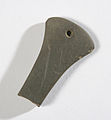|
Polada culture
The Polada culture (22nd to 16th centuries BCE) is the name for a culture of the ancient Bronze Age which spread primarily in the territory of modern-day Lombardy, Veneto and Trentino, characterized by settlements on pile-dwellings. The name derives from the same locality in the territory of Lonato del Garda in Lombardy where the first findings attributed to this culture were discovered in the years between 1870 and 1875 as a result of intense activities of reclamation in a peat bog; the dating of carbon-14 on the finds place them between c. 1380 BCE and c. 1270 BCE.[1] Other major sites are found in the area between Mantua, the Lake Garda and the Lake of Pusiano. It was succeeded in the Middle Bronze Age by the facies of the pile dwellings and of the dammed settlements and the Terramare culture. Chronology  The Polada culture is usually assigned to the period from 2200 to 1500 BCE, or according to A.F. Harding (2000) from 2400 to 1400 BCE,[2] David-Elbiali & David (2009) limit the time span between 2200 and 1750 BCE.[3] The so-called tavolette enigmatiche or Brotlaibidol found at Polada and in the Lago di Ledro date from the more recent period of the South Alpine Early Bronze Age and are correlated with the Polada culture. According to the chronology proposed by Renato Perini, they correspond to the Bronzo Antico II and Bronzo Antico III (Polada-B context). These clay objects can be dated in Italy in a period from 2050 BCE (Polada B, Lavagnone 2) to 1400/1300 BCE (Lavagnone, Isolone di Mincio).[4] According to Paul Reinecke's chronological system, the Polada culture is included in the Bronze Age stages BzA2 to BzC2, but according to David-Elbiali & David (2009) only BzA1a, BzA1b and BzA2a, i.e. Early and Developed Early Bronze Age. The settlement of Lavagnone 1 can be assigned to 2080/2050 BCE. Lavagnone 2 existed for 65 years (from 2050 to 1991/1985 BCE) and Lavagnone 3 began around 1984 BCE. Origin There are some commonalities with the previous Bell Beaker Culture including the usage of the bow and a certain mastery in metallurgy.[5] Apart from that, the Polada culture does not correspond to the Beaker culture nor to the previous Remedello culture. According to Barfield the appearance of Polada facies is connected to the movement of new populations coming from southern Germany and from Switzerland.[6] Together with the Polada culture in Northern Italy, the following cultures lived around the Alpine arch:
According to Bernard Sergent, the origin of the Ligurian linguistic family (in his opinion distantly related to the Celtic and Italic ones) would have to be found in the Polada and Rhone cultures, southern branches of the Unetice culture.[7] DiffusionMost of the sites attributable to this culture were discovered around the Lake Garda, between eastern Lombardy, Trentino and western Veneto and around the Lago di Viverone and the Lake Maggiore in Piedmont. Its influences are also found in the cultures of the Early Bronze Age of Liguria, Romagna,[8] Corsica[9] and Sardinia (Bonnanaro culture). SettlementsThe settlements in the area of lakes and marshes of Moraine are stilt houses resting on "drainage" [10] of horizontal trunks, arranged in layered platform or cassette. They had a relatively limited extension, about a hectare, and a population between 200 and 300 people per village. EconomyThe economy was based on breeding, hunting, farming, fishing and large-scale berry harvesting. In a site of this culture, near Solferino, was found the oldest example of domesticated horse in Italy.[11] Material cultureIf the pottery is still coarse, other human activities grow and develop: lithic industry, in bone and horn, wood and metals. The Bronze tools and weapons show similarities with those of the Unetice Culture and other groups in the north of Alps including the Singen and Straubing groups. Gallery
Major sites
PaleogeneticsMale individuals from Trentino in the Bronze Age (Paludei di Volano and Romagnano III) mainly belonged to Haplogroup G-M201, associated with the Early European Farmers.[12] See alsoNotes
Further readingWikimedia Commons has media related to Polada culture.
|












